Background: There are numerous challenges when performing clavicle reduction osteotomies for shoulder narrowing. One of these challenges is doing the surgery through very small incisions located close to the neck. How readily it is to work through these incisions depends on the overlying tissue thickness.
While everyone assumes that the soft tissue overlying the clavicles in thin, this is not always so. Some people have obvious clavicle show while others do not. The amounts of clavicle show is indicative of how thick the soft tissue layer over the clavicles is. In profound clavicle show in thin patients it is still at least 1 cm or more thick. But when no clavicle show is present at all the tissue thickness can easily be 3cm or more thick. At this tissue thickness removing a bone segment and bringing the two ends together becomes more difficult.
Another surgical challenge is that of the very curved clavicle shape. In more curved clavicle shapes the length of the mid-shaft is shorter. As this is where the removed bone segment is taken this pulls the curved portions of the bone closer together. With the application of a superior straight plate this places the outer screw holes of the plate at risk of potentially being slightly off the bone…risking poor screw engagement at this critical plate area.
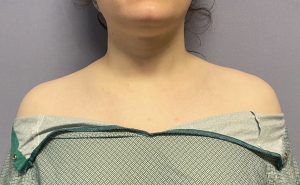
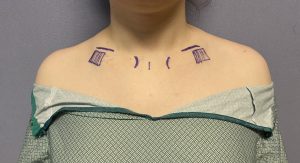 Case Study: This female desired to have less wide/square shoulders. Her current bideltoid distance was 48.5cms with clavicles lengths of 16cms. She had no visible clavicle show. By palpation the clavicles had a very curved shape.
Case Study: This female desired to have less wide/square shoulders. Her current bideltoid distance was 48.5cms with clavicles lengths of 16cms. She had no visible clavicle show. By palpation the clavicles had a very curved shape.

 Under general anesthesia clavicle reduction osteotomies were performed with the removal of 2.5cms per side were removed. Double plate fixation was applied with 3.5mm thick plate superiorly and 2.5mm thick plate anteriorly. Note how thick the overlying soft tissues are. In comparing a reduced right side vs a not yet reduced left side showed the differences in shoulder width.
Under general anesthesia clavicle reduction osteotomies were performed with the removal of 2.5cms per side were removed. Double plate fixation was applied with 3.5mm thick plate superiorly and 2.5mm thick plate anteriorly. Note how thick the overlying soft tissues are. In comparing a reduced right side vs a not yet reduced left side showed the differences in shoulder width.
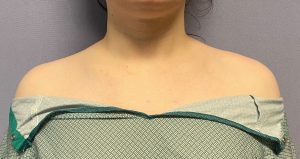
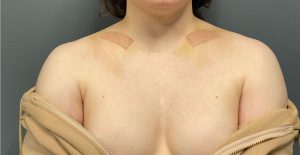
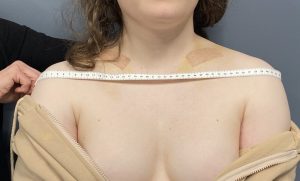 Her results seen 3 days after surgery showed the difference in shoulder shape with a reduction in bideltoid distance down to 44cms. (-4.5cms from preop)
Her results seen 3 days after surgery showed the difference in shoulder shape with a reduction in bideltoid distance down to 44cms. (-4.5cms from preop)
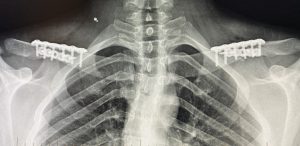 Her postop x-rays shows the double plate fixation and well aligned bone segments. Careful inspection shows the mismatch in size between the two bone ends. Even 2.5cms of bone removed results in two different size bone ends.
Her postop x-rays shows the double plate fixation and well aligned bone segments. Careful inspection shows the mismatch in size between the two bone ends. Even 2.5cms of bone removed results in two different size bone ends.
While all clavicles have a lazy s-shape some have more of an s-shape than others. This means that their ends have longer and greater curves with a reduced mid-shaft length. Since the bone removed in clavicle reduction osteotomies is taken from the mid-shaft section of the bone this brings the curved ends closer together. This potentially limits the length of the fixation plate that can be applied.
Case Highlights:
1) Patients with little to no clavicle show have thick overlying tissues which makes the limited incisional access used for the surgery challenging.
2) The very curved clavicle limits how much mid-shaft bone length can be removed as the two curved ends are pulled closer together.
3) In the very curved clavicle the limit of bone removal is 2.5cms per side.
Dr. Barry Eppley
Indianapolis, Indiana



